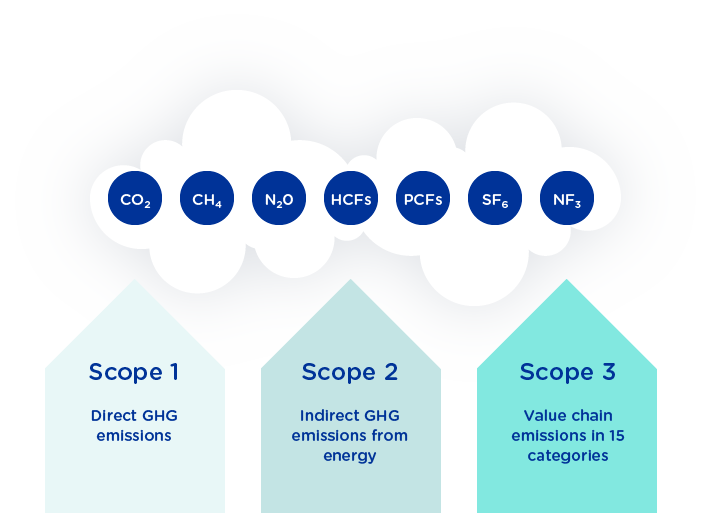
What Are Scope 1, 2, and 3 Emissions and Why Should Companies Calculate Them?
Scope 1, 2, and 3 emissions are the global standard for categorising a company’s greenhouse gas (GHG) emissions. This classification system, based on the Greenhouse Gas Protocol, is used by businesses and regulators around the world to track climate impacts and in calculating company carbon footprint.
Understanding Scopes 1, 2, and 3 helps organisations define their climate responsibilities, reduce the risk of double-counting, and meet the expectations of stakeholders and regulators. Scopes are important in ESG reporting, especially under the CSRD and other reporting frameworks.
Scope 1 Emissions: Direct Emissions from Company-Owned Sources
Scope 1 emissions are greenhouse gases tied directly the company’s operations. These include:
- Fuel used in company vehicles and machinery
- On-site energy generation (gas boilers, backup generators)
- Industrial emissions (e.g. chemical manufacturing)
- Emissions from equipment like refrigeration or air conditioning systems
Because Scope 1 emissions occur within the company’s own infrastructure, they are often the easiest to monitor and reduce. Many organisations begin their emissions reduction efforts here.
Scope 2 Emissions: Indirect Emissions from Purchased Energy
Scope 2 refers to indirect emissions associated with generating electricity, heating, cooling, or steam that a company purchases. These emissions happen at the energy provider’s facilities but are counted in the company’s footprint because the energy is consumed in business operations.
Examples of Scope 2 emissions:
- Electricity use in offices or factories
- Purchased heating or cooling
- Emissions from energy services not produced on-site
Reducing Scope 2 emissions often involves switching to renewable electricity and using energy more efficiently.
Scope 3 Emissions: Indirect Emissions Across the Entire Value Chain
Scope 3 emissions include all other indirect GHG emissions that occur as a result of the company’s activities, but from sources it does not own or directly control. These can be divided into upstream and downstream emissions.
Examples of Scope 3 emissions include:
- Emissions from the production of purchased goods and services
- Transport and logistics (inbound and outbound)
- Travel and employee commuting
- Waste processing
- Product use-phase emissions
- End-of-life treatment of products
- Emissions from investments
Scope 3 often represents the largest share of a company’s total climate footprint. Measuring Scope 3 emissions is challenging, but essential for any business serious about climate action.
Why Calculating Scope 1, 2, 3 Emissions is Now Important
Monitoring Scope 1, 2, and 3 emissions is no longer optional for many companies. Since 2014, the EU has required large companies to disclose climate impacts under the Non-Financial Reporting Directive (NFRD). With the implementation of CSRD in 2024, the scope of required reporting is expanding.
CSRD reporting requires companies to:
- Report Scope 1, 2, and 3 emissions in a traceable, auditable format
- Align emissions targets with the Paris Agreement
- Use approved methods such as the GHG Protocol
- Submit electronically tagged data to the European Single Access Point (ESAP)
Accurate emissions tracking is now part of strategic, long term business management. It supports risk analysis, stakeholder trust, and operational efficiency. It also helps SMEs prepare for increasing supply chain demands from larger corporate buyers subject to Scope 3 data requirements.

How to Calculate Scope 1, 2, 3 Emissions with Ecobio Manager
Ecobio Manager offers a Carbon Footprint Calculator that helps companies measure Scope 1, 2, and 3 emissions in line with international standards.
Navigating climate responsibilities becomes straightforward when insight, methodology, and technology converge in a single platform. Ecobio Manager Climate Toolbox combines a science-based carbon footprint calculator, a scenario risk and opportunity module, and forthcoming transition-planning support within software crafted by seasoned climate experts. Each element links seamlessly to CSRD, EU Taxonomy, VSME, TCFD (IFRS), CDP, and GRI requirements, turning raw data into audit-ready graphics, tables, and KPIs.
Future-Proof Your Business with Ecobio Manager Climate Toolbox
More than 17 000 quality-checked emission factors underpin precise Scope 1, 2, and 3 calculations, while scenario analysis tests strategies against high- and low-emission pathways so adaptation actions can be planned before risks materialise. Embedded guidance safeguards methodological accuracy that climate verifiers trust, and automated workflows lighten your reporting workload.
Contact us



